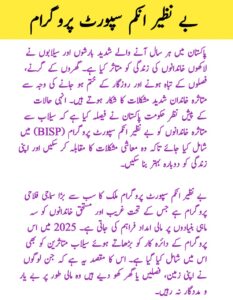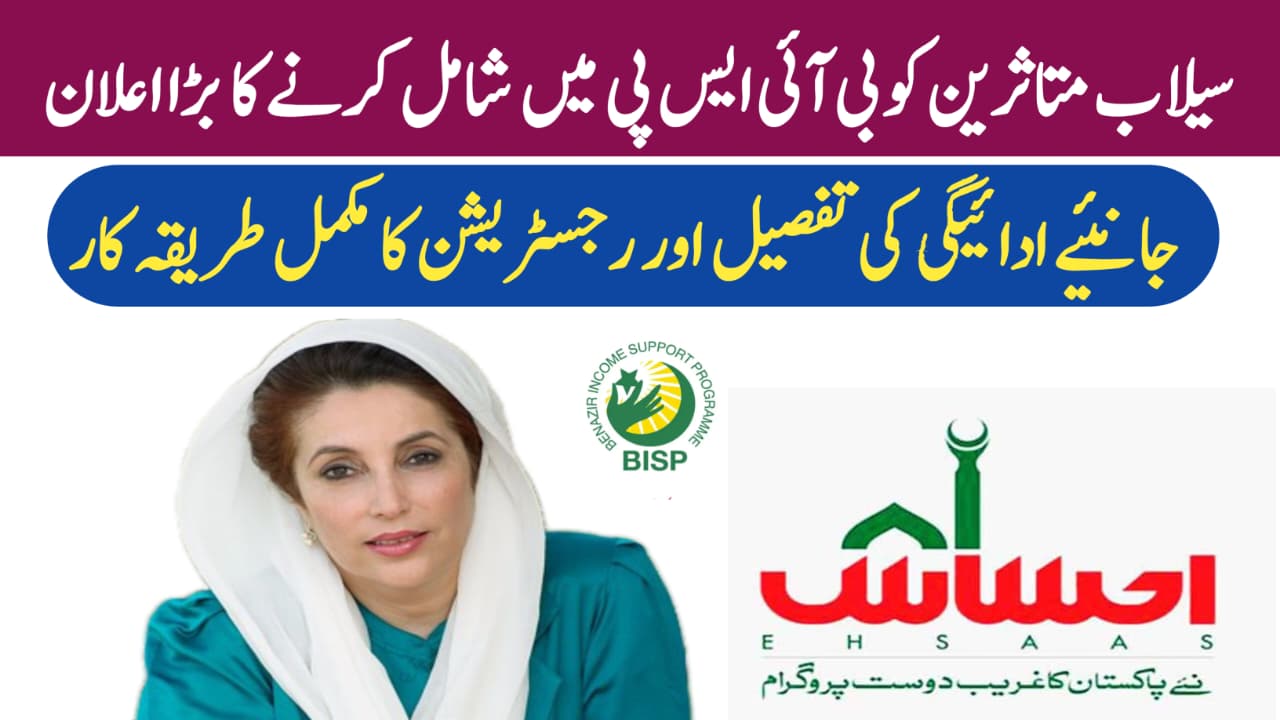Natural disasters such as floods have had devastating impacts on millions of families across Pakistan. Each year, thousands of households lose their homes, agricultural land, sources of livelihood, and even family members due to heavy monsoon rains and flash floods. To provide financial relief and ensure that these vulnerable families are not left behind, the Government of Pakistan has introduced special measures under the Benazir Income Support Programme (BISP).
In 2025, the government announced the inclusion of flood-affected families (locally referred to as mutasreen) into the BISP system. This means that families impacted by floods will be able to receive regular cash transfers and additional relief under the BISP Kafalat and 8171 programs.
This article provides a complete, in-depth guide to understanding how flood-affected families can register, what eligibility requirements are set, how much financial support they can expect, and what updates have been officially shared by BISP.
What is BISP and Why It Matters?
The Benazir Income Support Program (BISP) is Pakistan’s largest social safety net initiative. Launched in 2008, it provides financial assistance to the poorest and most vulnerable households in the country. Over the years, it has expanded its coverage to include millions of beneficiaries, ensuring that poverty-stricken families can access necessities such as food, healthcare, and education.
The program runs multiple schemes under its umbrella:
-
BISP Kafalat: Direct cash transfers every quarter to eligible women.
-
8171 Portal & SMS Service: For checking eligibility and registration status.
-
BISP Nashonuma: Nutritional support for pregnant and lactating women.
-
Education Support Programs: Scholarships for children of BISP beneficiaries.
Flood-affected families, who are among the most vulnerable groups in Pakistan, will receive special attention in 2025.
Flood-Affected  Families (Mutasreen) Need Support
Families (Mutasreen) Need Support
Floods destroy homes, crops, and infrastructure. For rural households depending on agriculture, this means losing their only source of income. Families often end up living in temporary shelters, struggling to buy food, clothing, or medicine.
By including flood victims in BISP:
-
They gain immediate financial relief.
-
Families can rebuild their homes gradually.
-
Children’s education is less likely to be disrupted.
-
Vulnerable women get direct financial empowerment.
This targeted inclusion ensures that disaster victims are not excluded from national welfare systems.
Flood-Affected Families Flood Victims in 2025
After a thorough assessment, the government has announced that it will include all verified flood-affected families in the BISP database. The following steps have been introduced:
-
Special Survey Drives: Teams are visiting flood-hit areas to collect data.
-
Dynamic Registration (NSER): Families need to update their information in the National Socio-Economic Registry.
-
PMT Score Adjustment: Poverty score thresholds have been adjusted to accommodate disaster victims.
-
Quick Disbursement Mechanism: Eligible families will start receiving payments within weeks of approval.
Eligibility Criteria for Flood Victims
Flood-affected families can qualify for BISP if they meet the following conditions:
-
Residence in Flood-Hit Areas: Families must belong to regions officially declared as disaster zones.
-
NSER Data Verification: Household details must be recorded in the National Socio-Economic Registry.
-
Low Poverty Score (PMT): Only families below the approved threshold are included.
-
No Government Employment: Households where a member is a government employee or pensioner are excluded.
-
No Overseas Income: Families with foreign remittances or international travel records may not qualify.
-
Valid CNIC: A computerized national identity card is mandatory for registration.
Registration Process for Flood Victims
Flood-affected households can register through the following methods:
1. 8171 SMS Service
-
Send CNIC number to 8171.
-
Receive a confirmation message about eligibility status.
2. 8171 Web Portal
-
Visit the official BISP 8171 portal.
-
Enter the CNIC number and family details.
-
Check application and payment status.
3. NSER Registration Centers
-
Visit the nearest BISP/NSER office.
-
Provide documents such as CNIC, proof of residence, and a disaster certificate (if issued).
-
Please complete the survey to calculate your poverty score.
4. Special Mobile Camps
-
In flood-hit regions, mobile registration camps are set up.
-
Officials directly collect data from displaced families.
Financial Assistance Amount
As of 2025, the BISP Kafalat program provides PKR 13,500 every three months to each eligible household. Flood-affected families included in the program will receive the same amount.
In addition, there may be special one-time relief packages announced by the provincial or federal government for disaster victims, especially in the case of large-scale destruction.
Benefits of Inclusion for Flood Victims
The inclusion of mutasreen in BISP brings multiple advantages:
-
Direct Cash Transfers: Helps meet immediate needs like food, clothing, and medicine.
-
Women’s Empowerment: Payments are made in the name of women (head of household), ensuring gender inclusion.
-
Children’s Education Support: Scholarships available for school-going children.
-
Nutritional Programs: Special support for pregnant women and children under five.
-
Long-Term Stability: Reduces families’ vulnerability to future disasters.
Government Announcements and Updates
In recent updates, government officials confirmed that:
-
Hundreds of thousands of families have been added to BISP after being verified as flood victims.
-
The PMT cut-off score was relaxed to ensure more inclusion.
-
A large number of ineligible beneficiaries were removed to make space for more deserving flood-affected families.
-
Areas hardest hit by floods, such as Sindh, Balochistan, and South Punjab, are fast-tracking verification and payments.
Challenges in the Process
Despite the positive steps, there are some challenges:
-
Delays in Survey: Large-scale data collection takes time.
-
Fake Claims: Some non-affected families try to register.
-
Infrastructure Issues: Flood-hit areas have damaged roads, making access to camps difficult.
-
Awareness Gap: Many families do not know about the registration process.
How to Check Your Status
Families can check their eligibility and payment status easily:
-
By SMS: Send CNIC to 8171.
-
By Online Portal: Use the official BISP website.
-
By Visiting Office: Go to the nearest BISP Tehsil Office.
Future of BISP for Flood Victims
The government plans to integrate disaster relief more strongly into BISP in the future. Some proposals include:
-
Automatic inclusion of disaster victims through NADRA and NDMA data sharing.
-
Additional one-time payments for newly affected families.
-
Digital payment systems for faster disbursements.
-
Increased monitoring to ensure transparency.
Conclusion
The inclusion of flood-affected families (mutasreen) into the Benazir Income Support Programme (BISP) 2025 is a vital step toward protecting the most vulnerable citizens of Pakistan. By extending regular financial aid, ensuring women’s empowerment, and providing education and nutrition support, the program helps families recover from floods and strengthens social safety nets across the nation.
If you or someone you know has been affected by floods, it is essential to complete the registration process through 8171 SMS, the web portal, or NSER offices. Timely registration ensures that deserving families receive the support they urgently need.
For More Information Click Here
